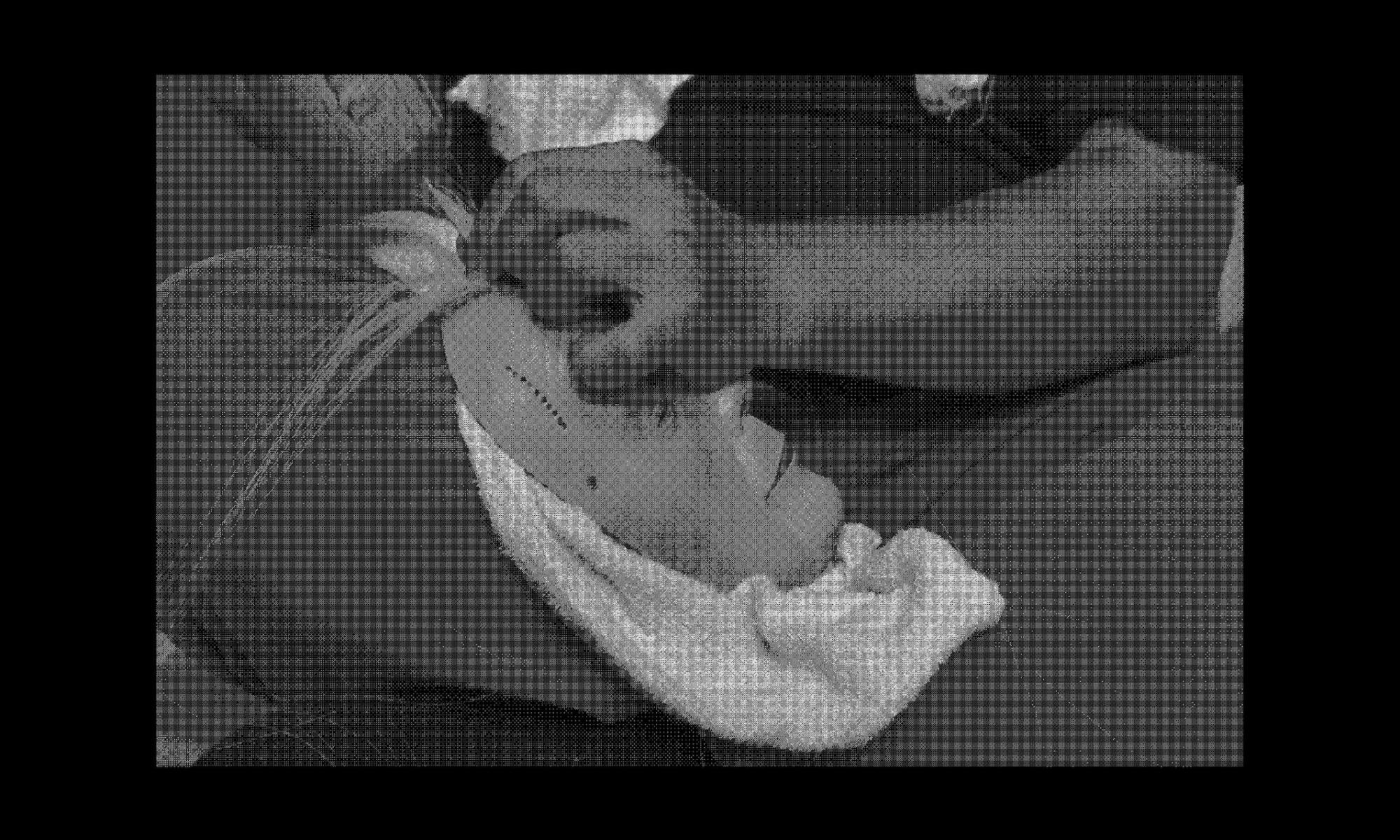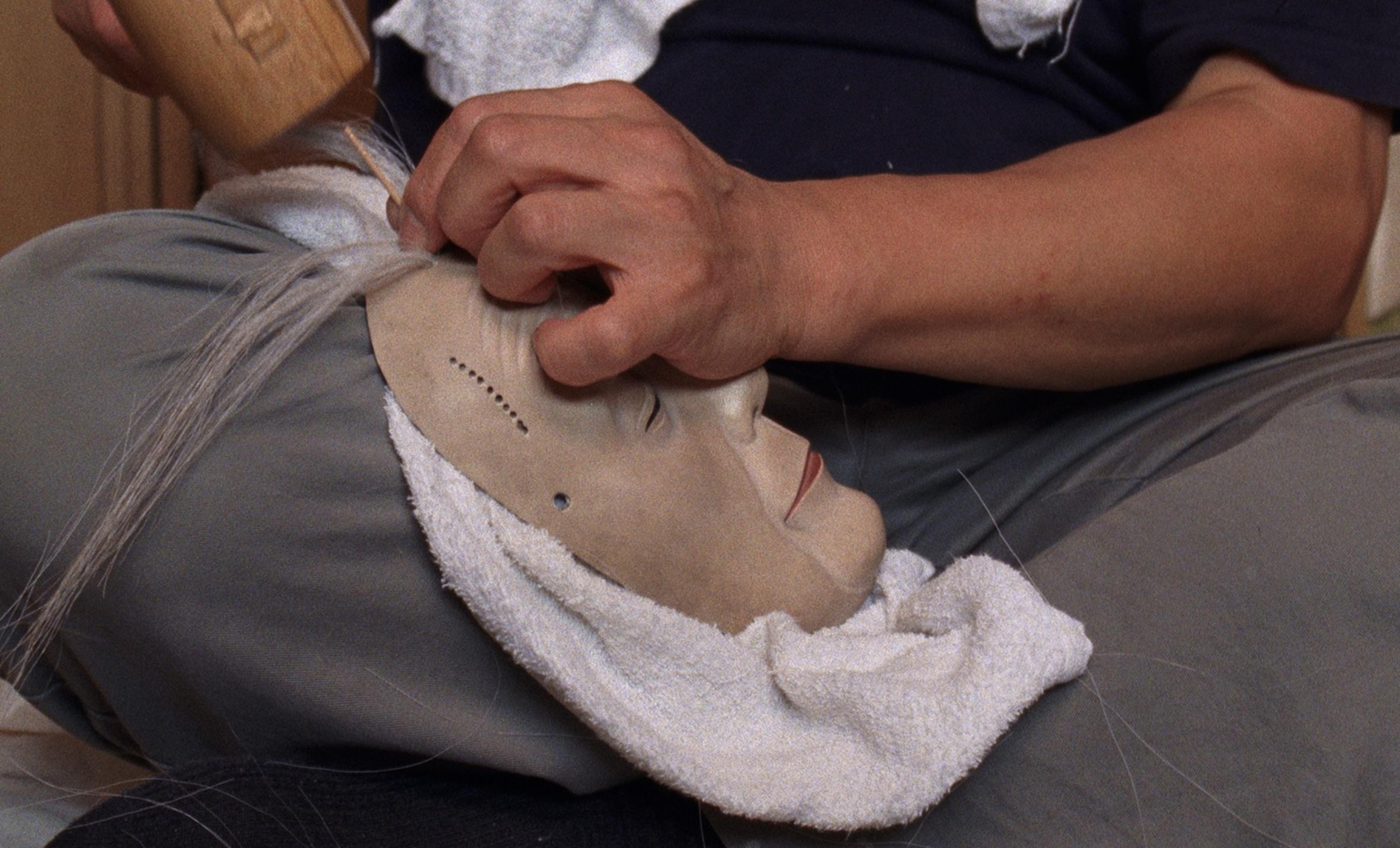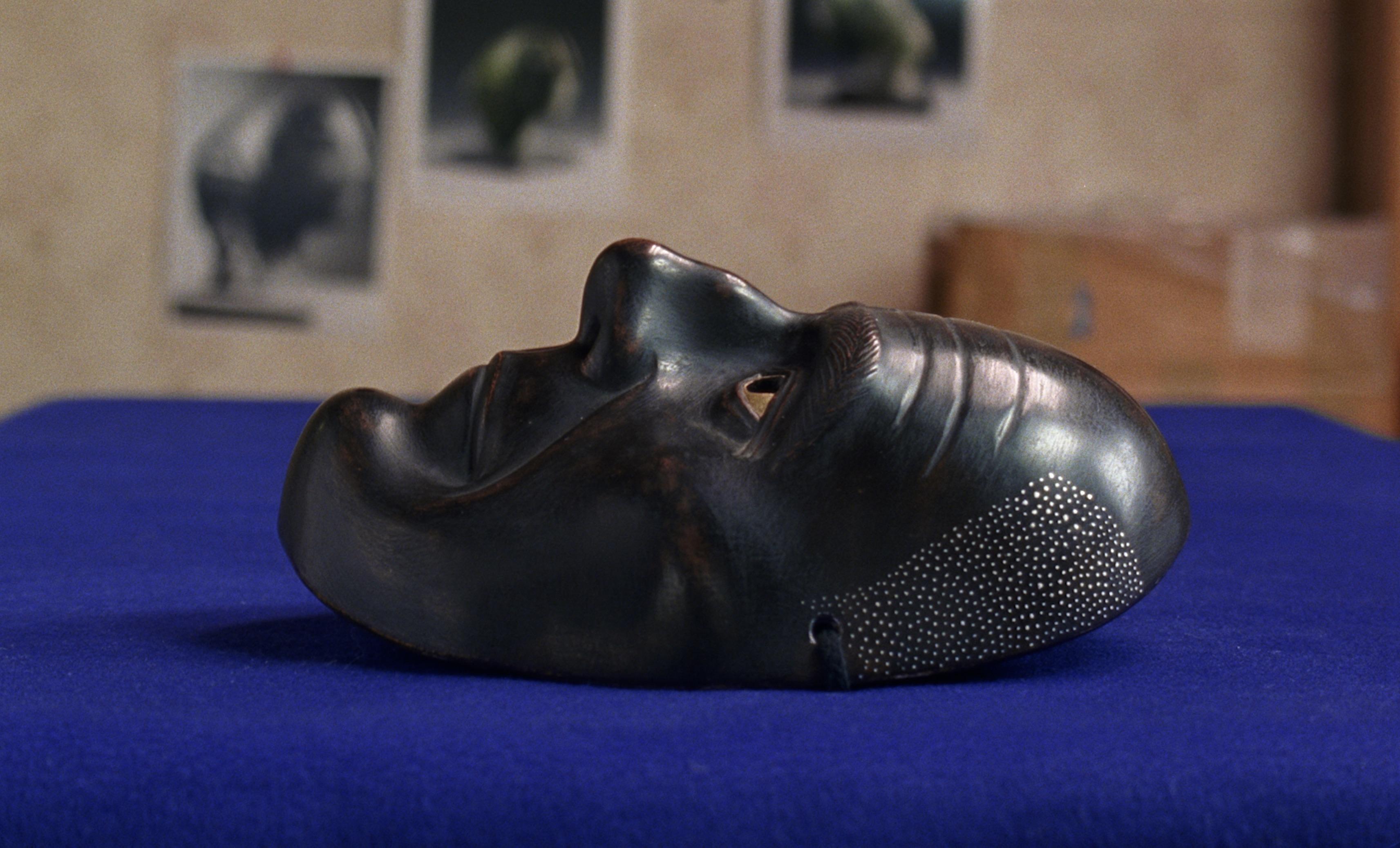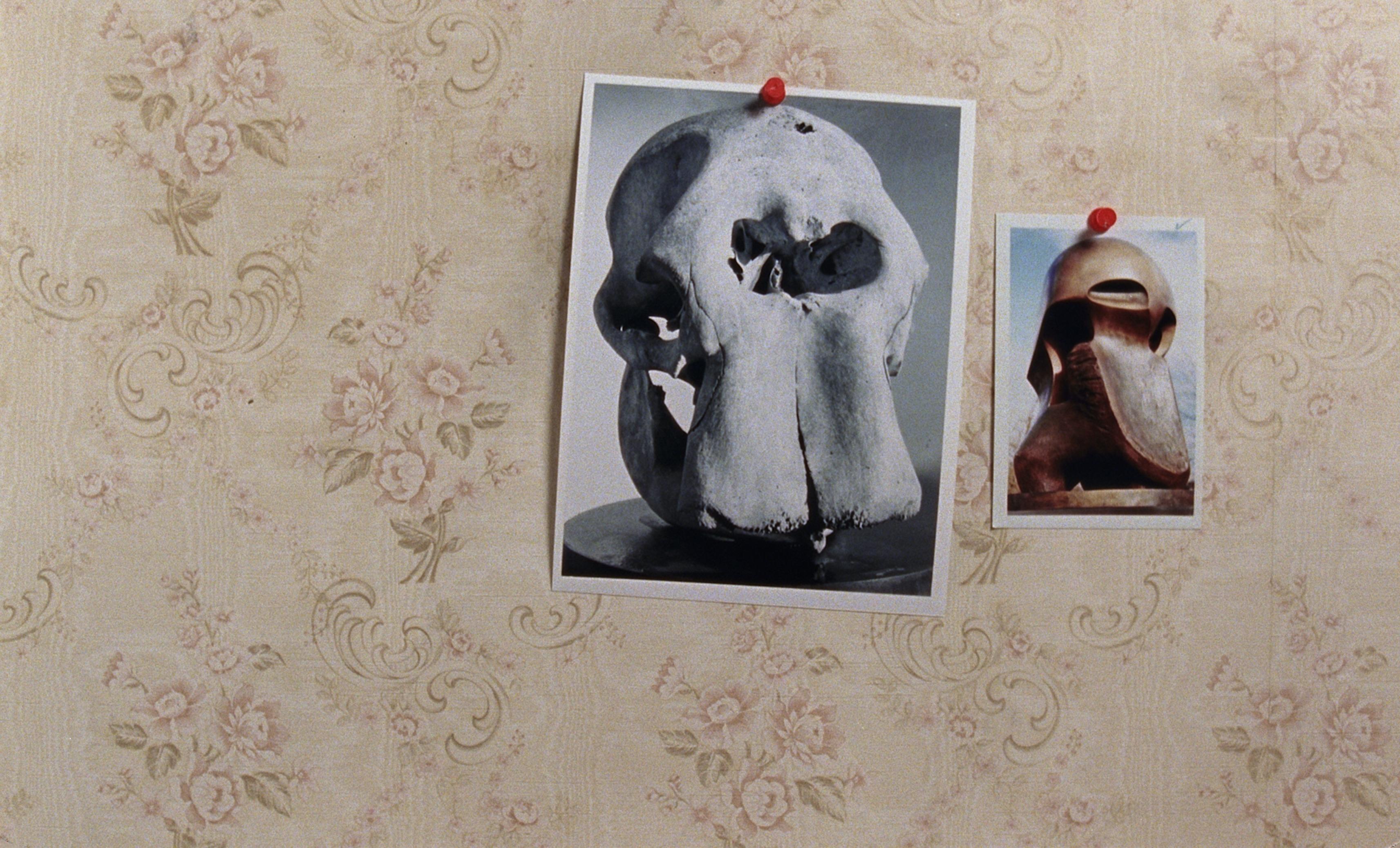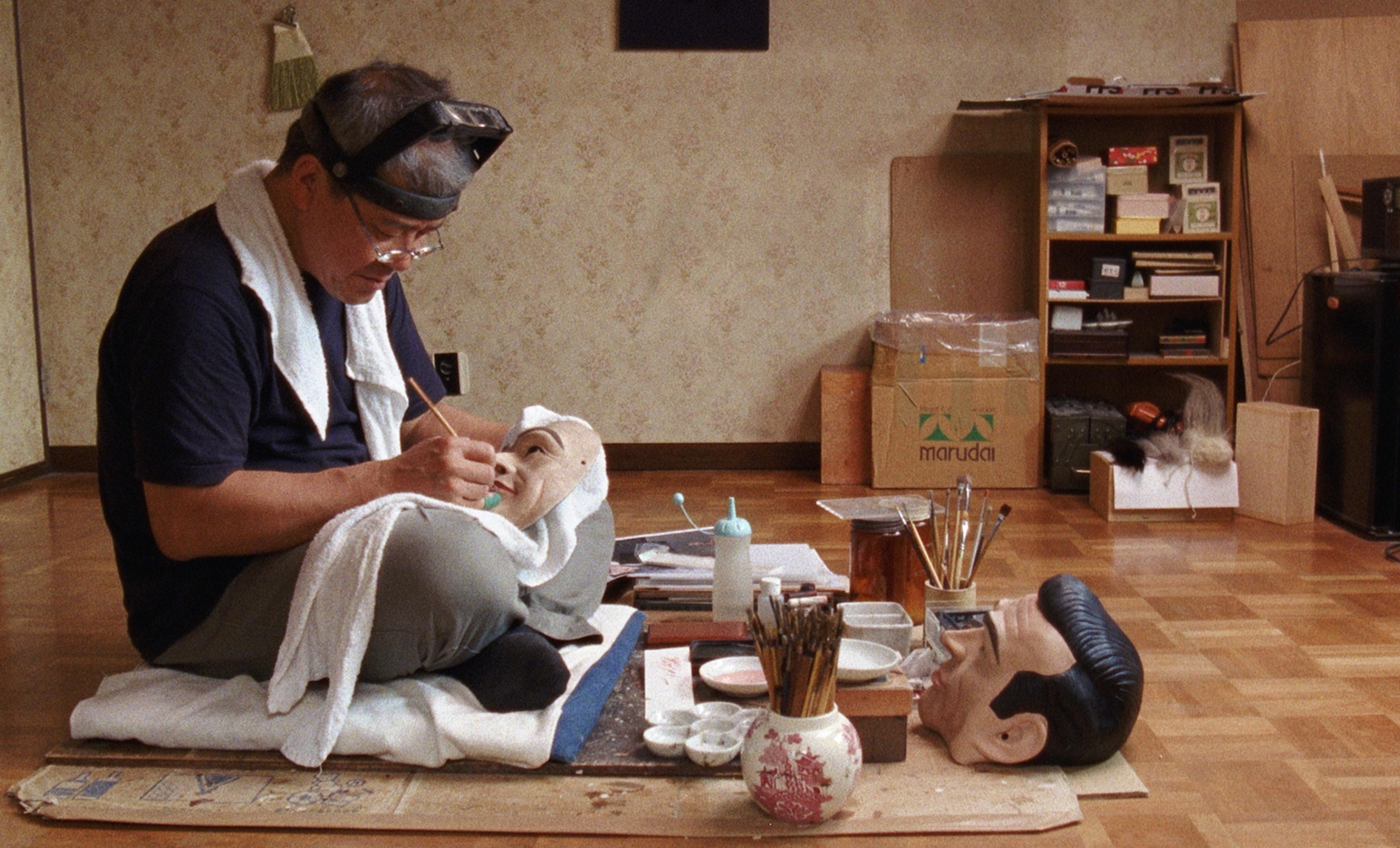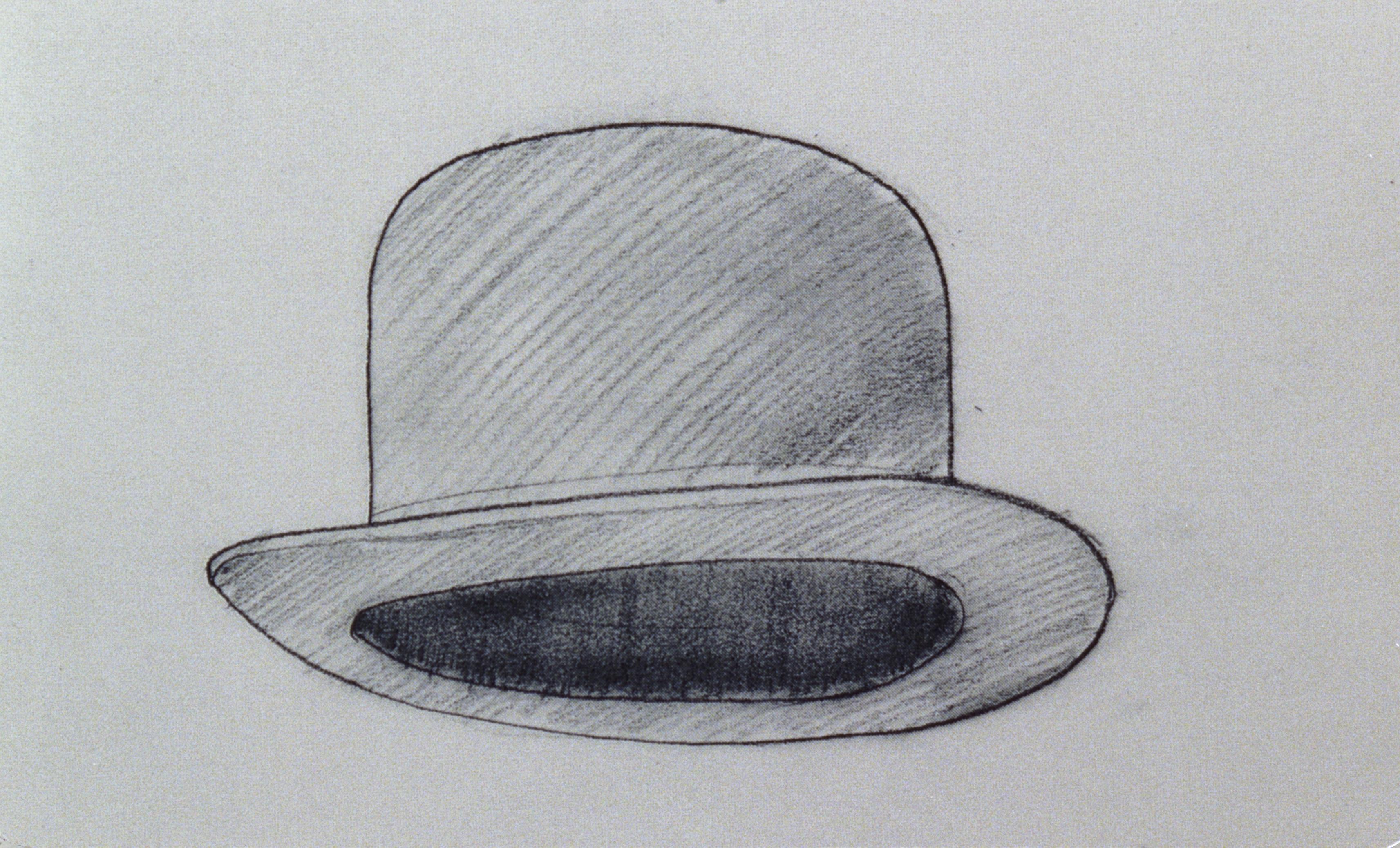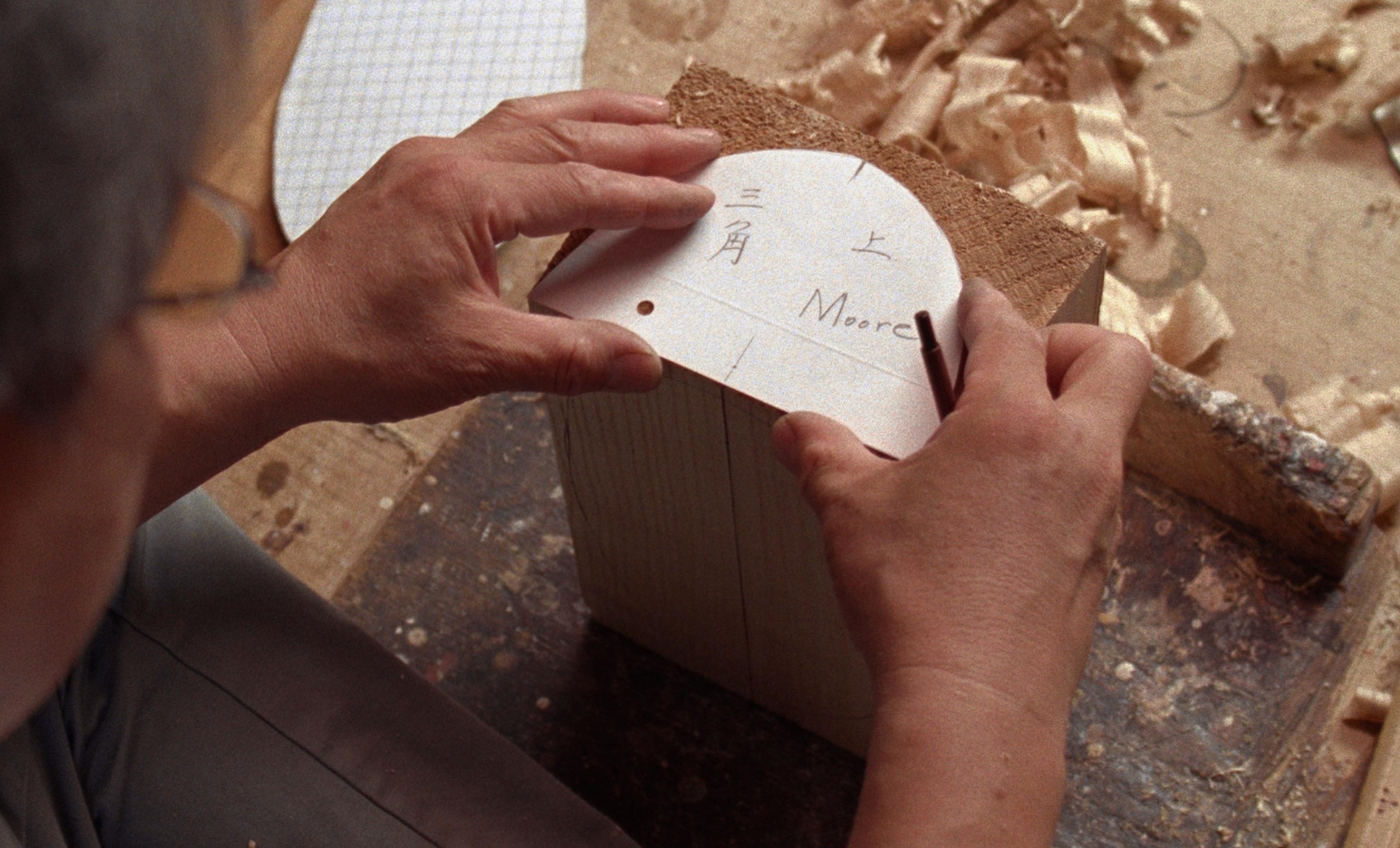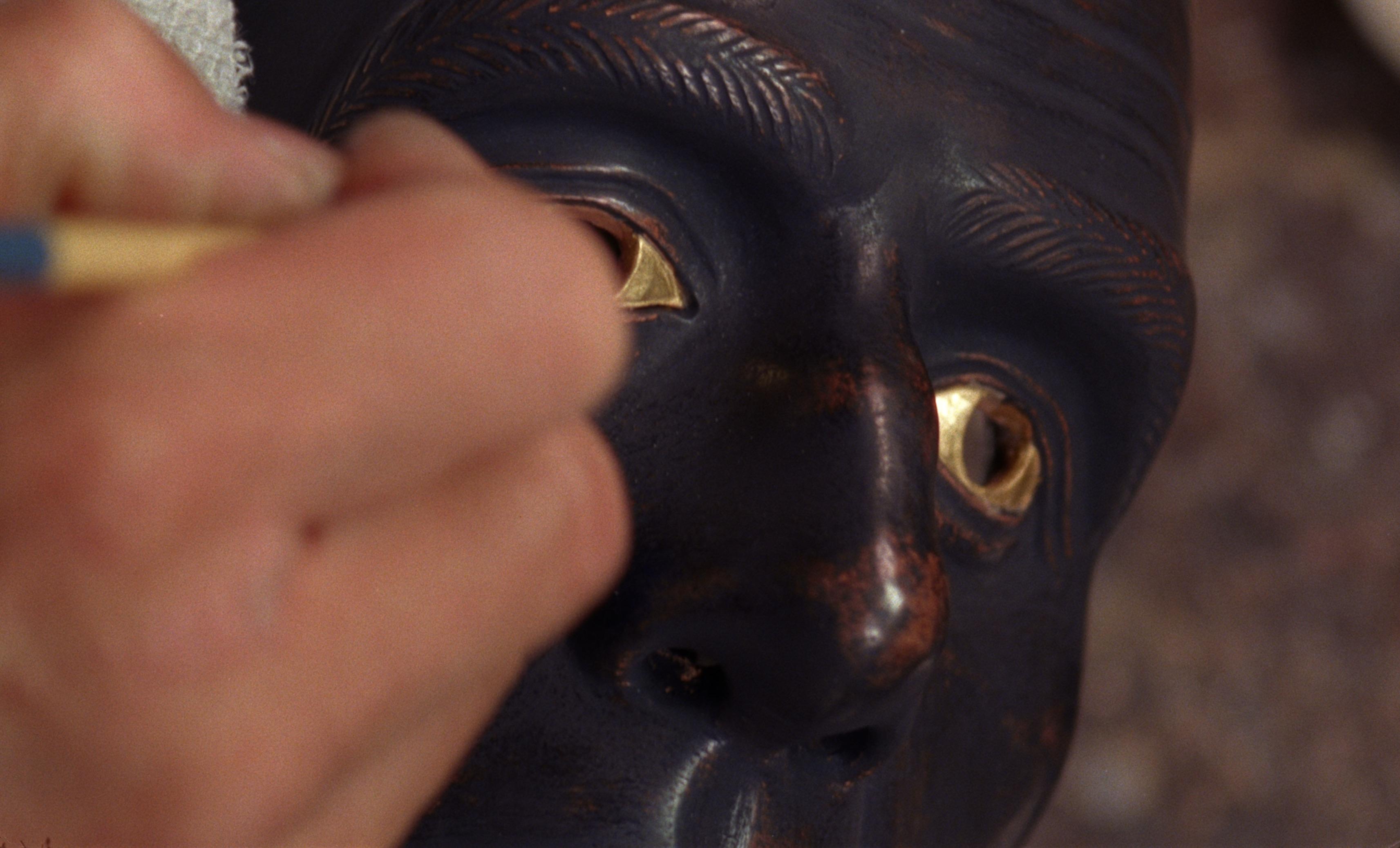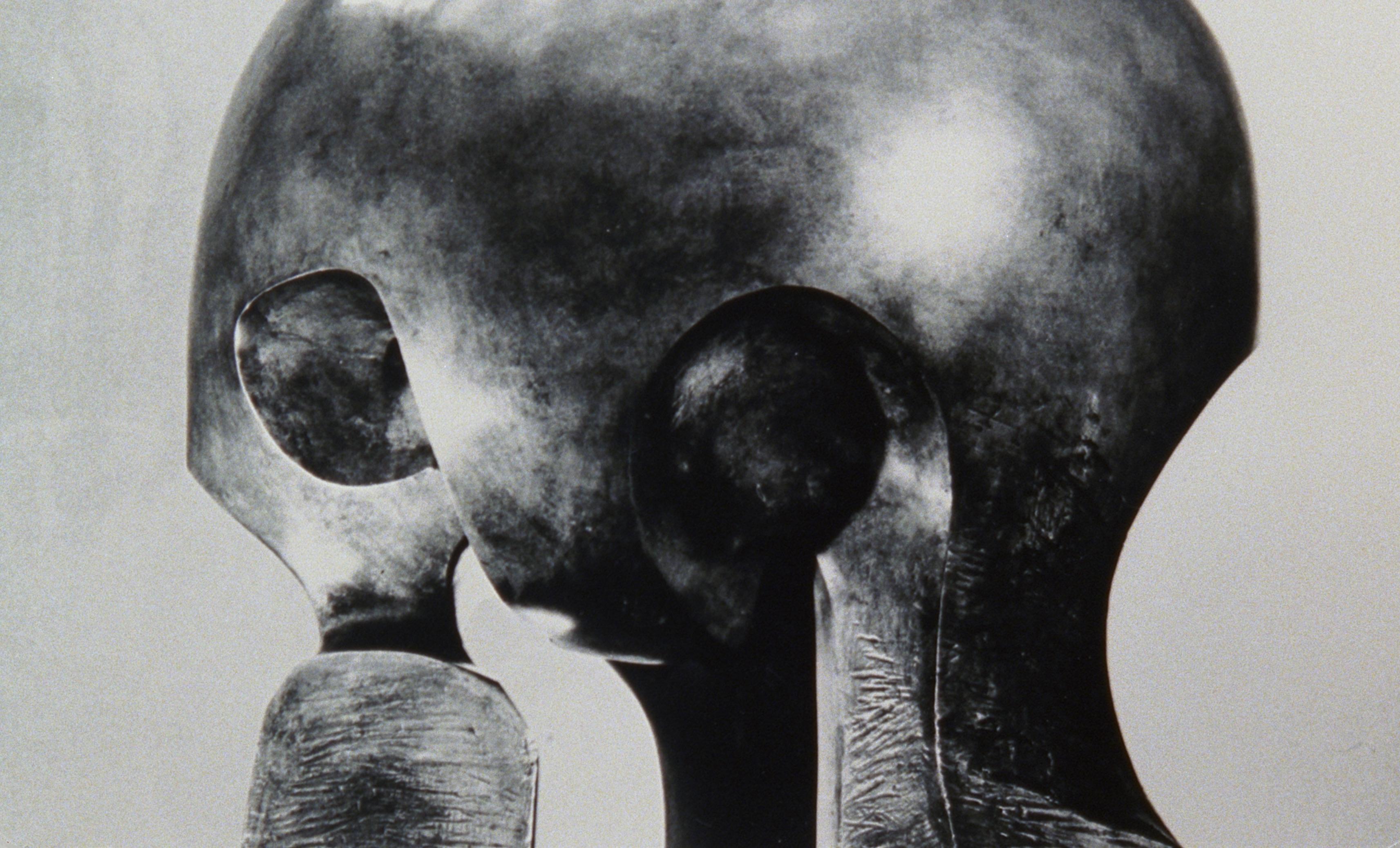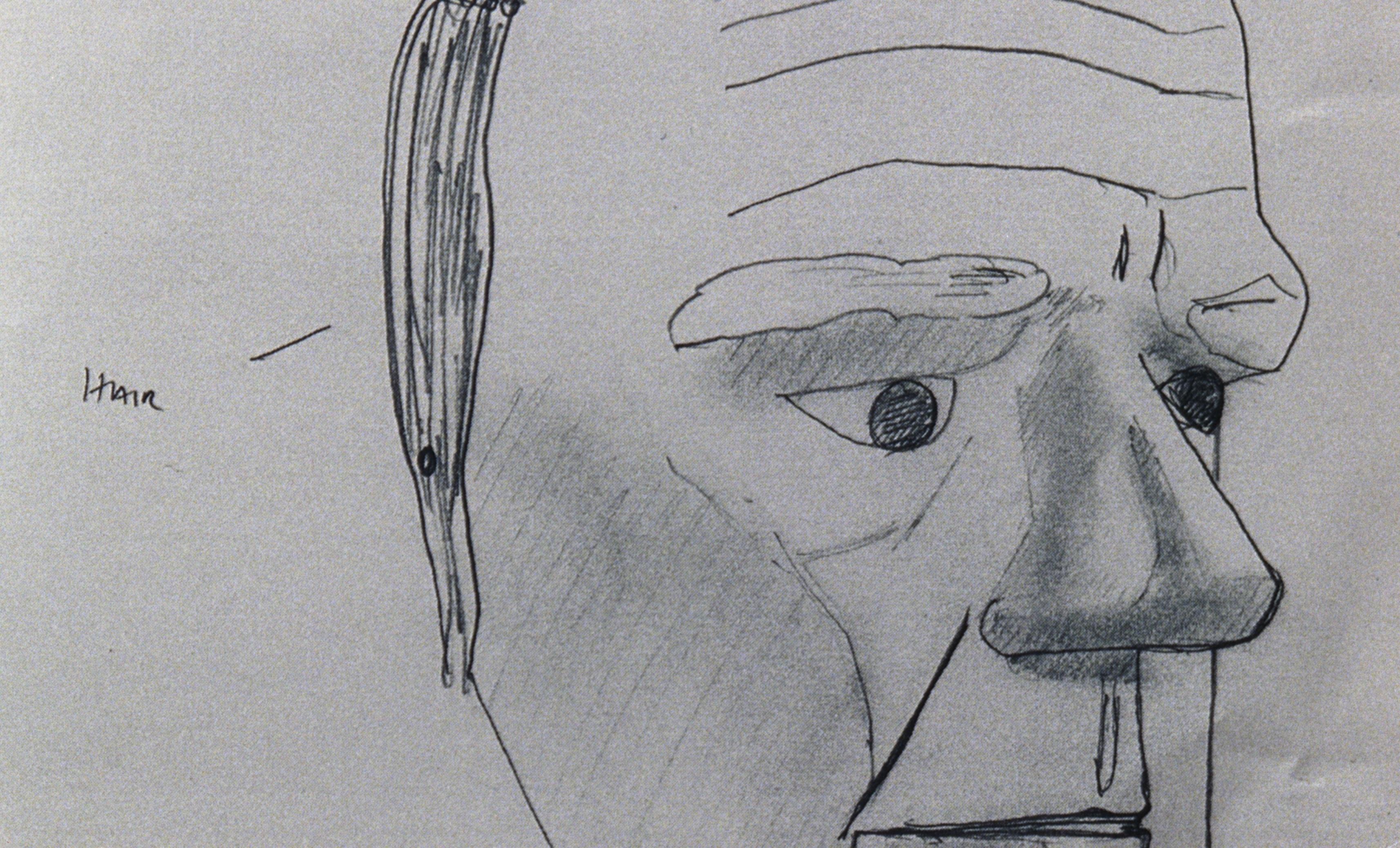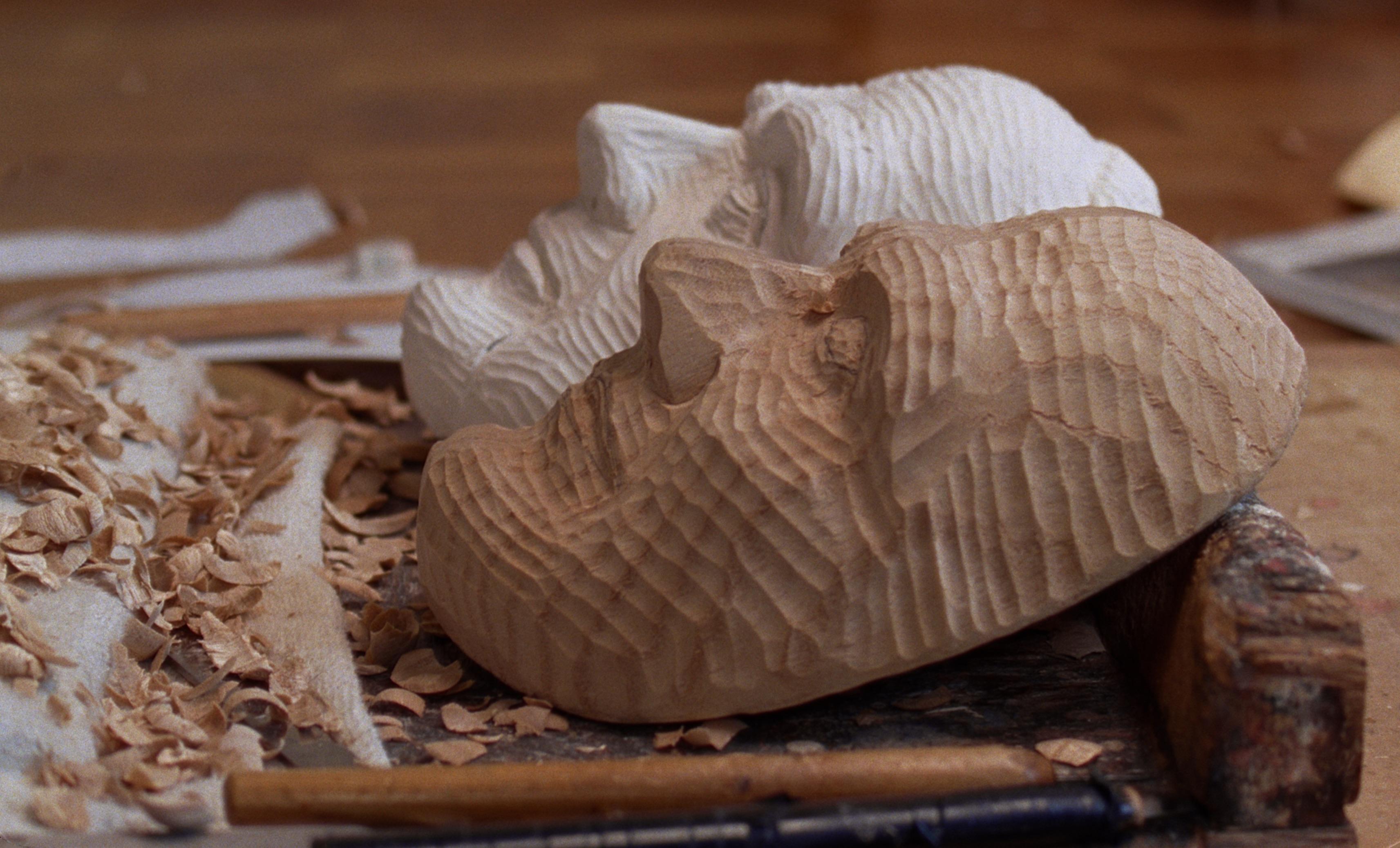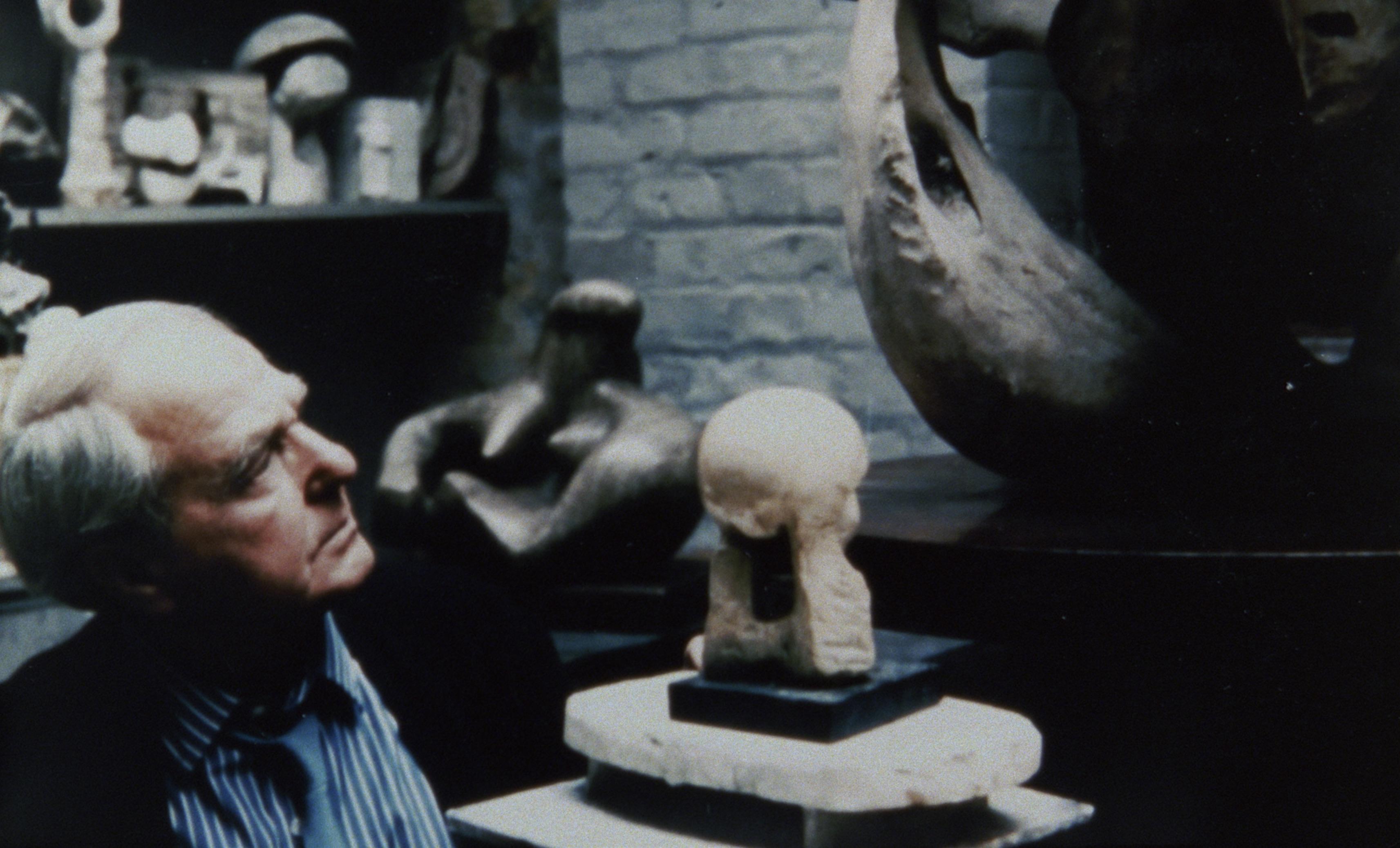Project For A Masquerade (Hiroshima)
By Simon Starling
The Mirror Room
The Stage
The Play
EBOSHI-ORI
A 16th century Japanese tale of personal reinvention, double identities and disguise, restaged as a Cold War drama with:
James Bond
Joseph Hirshhorn
Enrico Fermi
Anthony Blunt
Colonel Sanders
And with the multifaceted
Atom Piece
As Ushiwaka, the exiled son of the defeated Lord Yoshitomo—fleeing from incarceration in the Temple of Mount Kurama
with the help of
Henry Moore
as the hat maker who fashions his disguise.
The positions of the 12-strong unmasked Noh chorus will be filled by a Polish-American street gang, Chicago’s
The Back of the Yards Boys
The first characters to cross the bridge that links the Noh dressing room, the so-called Mirror Room, to the Stage are—
The Gold Merchant
Kichiji
And his brother
Kichiroku
In the highly ritualised atmosphere of the Mirror Room, the principle actors fit their masks and are physically possessed by the characters they will portray on stage. It is a space in which identities are traded, ghosts assume human form, men are transformed into women, the young become old, and the old young.
Once on stage, Kichiji and Kichiroku are soon joined by the young noble boy—
Ushiwaka
Our two gold merchants have “amassed a great store of treasure” and are taking it east to sell. When Ushiwaka asks to join them on their journey, they are initially skeptical of his motives but eventually agree that he might join their party—a decision that will finally save their lives and their fortune as later in the play Ushiwaka singlehandedly fights off the notoriously opportunistic bandit Kumasaka and his band of Brigands.
In this Cold War restaging of the Japanese classic, the role of Kichiji will be played by James Bond, as portrayed by Sean Connery in the 1964 film adaptation of Ian Fleming’s 1959 novel Goldfinger. The novel’s eponymous villain, Auric Goldfinger, threatens global economic stability by accumulating huge quantities of gold and smuggling them to the Russians disguised as car body panels for his Rolls Royce Silver Ghost. In the film version of the novel’s 27 page-long game of cat and mouse on the golf course, Bond, posing as an illicit gold merchant, drops a bar of Nazis gold on the green just as Goldfinger is about to put—this hook and the promise of more such bars, gives the undercover agent a momentary foothold in Goldfinger’s smuggling operation which finally allows him to foil plans to irradiate the entire US gold reserve with a Russian built nuclear device—preventing a dramatic shift in global economic power.
As Ushiwaka and his two new travelling companions stop for the night at the Mirror Inn, a messenger arrives from the Temple of Mount Kurama—from where Ushiwaka has escaped. Played by the Nobel Prize winning physicist Enrico Fermi who is in turn under-studied by his fellow Roman and near double, Scipio Africanus the Elder, the messenger has been sent to “fetch back Lord Yoshitomo’s son”, Ushiwaka. Fearing that alone he will be unable to detain the young boy he returns home to fetch help.
Both Enrico Fermi and his understudy Scipio Africanus were victims of Benito Mussolini’s ambitions—Scipio posthumously co-opted as the elephant riding, eponymous hero of a 1937 fascist film (his life story cruelly exploited for propagandist ends), the brilliant Fermi fleeing an increasingly anti-Semitic Rome for the United States in 1938 with his Jewish wife, Laura Capon.
Following initial experiments in nuclear fission at New York’s Columbia University, Fermi moved his research to Chicago and, with the help of a young Polish American street gang known as the Back of the Yard Boys (our chorus), built Chicago Pile 1 with which he achieved the first-ever sustained nuclear chain reaction. The success of this somewhat speculative experiment, carried out in a disused rackets court under the west stand of Chicago University’s Stagg Field Football Stadium, led to the building of the larger Hanford production reactor and to Fermi’s move to Los Alamos, New Mexico, to work with J. Robert Oppenheimer’s team in the drive to build the first atomic bomb. On the 6th of August 1945 a single B-29 bomber, the Enola Gay, dropped Little Boy on the Japanese city of Hiroshima, killing some 200,000 people.
The messenger’s fleeting appearance on stage is enough to prompt Ushiwaka’s late-night visit to a hat maker to seek assistance in creating a disguise. He decides to cut his hair and wear a highly encoded eboshi hat folded to the left—a hat outlawed by the local ruling Taira clan—in order that he might be mistaken for an ‘Eastern boy’ and so escape unnoticed. Despite the lateness of the hour and the controversial nature of his request, the kindly hat maker agrees to produce the hat.
The arrival of Ushiwaka at the hat maker’s shop sends shock waves through the lives of the hat maker and his wife. In return for making a perfect left-folding eboshi so late at night, Ushiwaka presents the hat maker with a sword. At first, the hat maker refuses the sword as payment but eventually presents it to his wife—on seeing the sword she immediately starts to cry and admits to her bemused husband that she has a secret past. She reveals that she is in fact Lady Akoya, the sister of Kamada Masakiyo an ally of Ushiwaka’s dead and defeated father, Lord Yoshitomo. Lord Yoshitomo had sent this charm-sword, known as Konnentō, to Ushiwaka’s mother as a gift and the hat maker’s wife had been “the messenger whom he charged to carry it” and who still mourns the loss of her former master and the regime he was unable to sustain.
As with all female roles in Noh theatre, the hat maker’s wife is played by a masked man – in this case the once-celebrated art historian and infamous Soviet spy, Sir Anthony Blunt.
The youngest son of the Revd Stanley Vaughan Blunt and Hilda Violet Master, Anthony Blunt spent much of his early life in Paris, became fluent in French and had close contact with the artistic culture of the city. He was educated at Marlborough College and then Cambridge University, studying maths, modern languages and finally pursuing graduate studies in art history. While at university, Blunt became a member of the Cambridge Apostles, a largely Marxist secret society and after visiting the Soviet Union in 1933 was recruited by the NKVD—The People’s Commissariat for Internal Affairs. In 1945 Anthony Blunt was appointed Surveyor of the King’s Pictures and two years later became Professor of Art History at the University of London and Director of the Courtauld Institute of Art. While it is clear that Blunt’s great passion as an art historian was for the paintings of Nicolas Poussin and the architecture of the Italian Baroque and that his strong political views at times strained his relationship to avant-garde art, he wrote with great conviction on the work of a number of contemporary artists, most notably Pablo Picasso, whose painting Guernica he described as “the last great painting in the European tradition” and Henry Moore, whom he described, in decidedly un-Marxist fashion, as “a sculptor of genius”.
Following studies at Leeds School of Art and the Royal College of Art, London and travels in France and Italy, our hat maker Henry Spencer Moore established a studio in the avant-garde milieu of late 1920’s Hampstead. Close neighbours included artists, writers, architects, philosophers and activists such as Naum Gabo, Herbert Read, Erno Goldfinger and F. H. K. Henrion. He is said to have joined the Communist Party in the 1930’s and was an active campaigner for peace and resistance to the rise of Fascism.
During World War II Moore became an official war artist, making drawings during the Blitz of sheltering figures in the London Underground, a process which was later restaged for a documentary film, but was finally forced to leave London when his Hampstead home was bombed. With his émigré Russian wife, Irina, Moore made a new home and studio in the rural setting of Perry Green in Hertfordshire from where, supported by influential art historians such as Herbert Read, Kenneth Clark and Anthony Blunt, he established a truly global reputation as the most important British sculptor of his generation.
The war-like mask of our hero Ushiwaka is based on a sculpture which itself had a complex early life and achieved what might be described as a double identity–Henry Moore’s Atom Piece. This multifaceted sculpture, a domed-form on a rough-hewn tripod, was renamed Nuclear Energy on the insistence of its commissioners, the Chicago University, for fear that the use of the word ‘piece’ (p-i-e-c-e) might be confused with ‘peace’ (p-e-a-c-e) and who selected the work to mark the site of the first self-sustaining nuclear reaction (Chicago Pile 1)—the beginning of what was to be known, much to the displeasure of Chicago, as the Manhatten Project, and which led at great speed to the building of the first atom bomb.
Henry Moore’s monumental sculpture Nuclear Energy, started life in December 1963, some months before the approach from the Chicago commission, as a tiny plaster maquette with clear links to F.H.K. Henrion’s landmark poster for the Campaign for Nuclear Disarmament designed in the same year and indeed to the campaign’s three legged logo. Despite being an early supporter of the Campaign for Nuclear Disarmament, Moore later attempted to distance himself from these more political associations by commissioning the photographer Errol Jackson to make a series of photographs of him working on the long-finished maquette next to an elephant skull, which came into to his possession after the maquette’s original completion. The two-stage scaling up of the sculpture generated a working model, which Moore continued to refer to as Atom Piece, and from which a bronze edition was cast. In 1986, and seemingly on the insistence of the by then dying artist, No. 1 of the edition was sold to the Hiroshima City Museum of Contemporary Art.
Following the completion of Ushiwaka’s disguise, the play move swiftly forward to the following evening, when, after a long day on the road, the three weary travellers, Ushiwaka, Kichiji and Kichiroku arrive at the Inn of Akasaka, an old staging post east of Kagami. The Innkeeper welcomes them but implores them to be on their guard as a “desperate gang” has got wind of their coming and has “sworn to set upon them” come nightfall.
The Innkeeper’s cameo role is to be played by Colonel Sanders as depicted in the many fibreglass effigies that welcome customers to the Kentucky Fried Chicken restaurant franchises of Japan. This hybrid figure is a somewhat conflicted symbol of post-war American influence in Japan, part Harland David Sanders, the Kentucky entrepreneur and founder of KFC, and part fat, grinning Ebisu, the Buddist god of merchants. The Colonel is to be under-studied by the celebrated American baseball “slugger” Randy William Bass, himself a near-deity in Japan. Bass single-handedly turned around the dismal fortunes of the Hanshin Tigers baseball team—powering them to victory in the Japan Series of 1985—the likeness between the two men, such as it is, was a trigger for an effigy of the Colonel to be tossed into the river during ecstatic celebrations following this victory. The Colonel’s stolen effigy was recently found and pulled from the river and his face now bares the scars of his 25-year-long, riverbed sojourn.
As evening turned to night, the brave Ushiwaka, goes out alone to meet the assault from Kumusaka’s band of brigands—“the lashing of the white waves”.
Legend has it that whilst still a boy Ushiwaka escaped his “strange servitude” in the Temple of Mount Kurama for the mountains where he met a long-nosed goblin, Tengu, from whom he learned “divine techniques” and became an extraordinarily skilled swordsman.
The skirmishers are repelled.
Some slain, other’s grievously wounded.
On hearing of a mere boy of twelve or thirteen slashing about him with a sword—“nimble as a butterfly or bird”, Kumusaka stirs his men for one last assault.
Come robbers, to the attack!
The theatrical-shoes of Kumusaka are to be filled by the Latvian born entrepreneur Joseph Hirshhorn who once proclaimed “My name is Opportunity.” His brigands are in turn played by Auric Goldfinger’s bowler-hated henchman, Oddjob and Henry Moore’s 1954 sculpture, “Warrior with Shield”.
By the age of 17 Joseph Hirshhorn was working as a stockbroker on Wall Street, enjoying rapid financial success and avoiding the 1929 crash by selling all of his assets just two months before the markets plummeted. He invested large amounts of the $4 million dollars he’d made from his activities on Wall Street in gold and later uranium mining prospects in Canada, establishing a Toronto office in 1933.
With the help of the geologist Franc Joubin, he identified and, in a complex and highly secretive operation involving 1,400 claims staked by hundreds of paid individuals who were forced to camp in the wilds for a month each, established the ‘Big Z’, a 90 mile-long, zig-zag shaped tract of uranium-rich land close to the town of Blind River, Ontario. By 1960, when he sold the last of his uranium stocks he had made over $100 million from the industry, in large part due to the activities of the uranium-hungry US Atomic Energy Commission and the on-going nuclear arms race. His business dealings in Canada attracted attention from the Ontario Securities Commission and as well as being fined for illegally smuggling cash out of Canada, he was twice convicted of breaking Canadian foreign exchange laws.
Almost from the moment he started making money Joseph Hirshhorn began to buy art and soon established himself as one of the most prolific collectors of art in North America. By the end of his life he owned over 5000 paintings and sculptures from the 19th and 20th centuries including 55 works by our hat maker, Henry Moore.
Eboshi-ori reaches its carefully choreographed climax as Kumusaka meets his young nemisis, Ushiwaka, in hand-to-hand combat.
Here The Back of the Yards Boys, our unmasked chorus, come into their own as they sing on behalf of the principle actors whose masked exertions make singing impossible. The Back of the Yards Boys where recruited by Enrico Fermi to machine four hundred tons of graphite into bricks and press uranium oxide into twenty-two thousand small spheres. After weeks on the job, the boys were provided with dust masks but refused to wear them as it interfered with their frequent singing and smoking.
Our chorus, still deploying the typical repetitions and narrow dynamic range of Noh theatre, describes how, kicking off his iron-shoes, Kumusaka leaps into battle and deeply versed in the use of the battle-sword, lunges with his left foot and in quick succession executes—
The Ten-Side Cut,
The Eight-Side Sweep,
The Body Wheel,
The Hanyū Turn,
The Wind Roll,
The Blade Drop,
The Gnashing Lion,
The Maple-Leaf Double,
The Flower Double.
Fire dances at the sword-points. The sword-backs clash.
At last even Kumusaka’s great battle-sword has spent its art—parried by the little belt—sword of Ushiwaka.
Finally Kumasaka throws down his sword and spreading out his great hands rushes wildly forward. But Ushiwaka dodges him, and as he passes mows round at his legs. The robber falls with a crash and, as he struggles to rise, the belt-sword of Ushiwaka smotes him clean through the waist.
And Kumasaka, that had been one man, lies cloven in twain.
Camera
Christophe Manz
Sound
Annette Ueberlein
Sound Mixing
Jochen Jezussek
Music
Extracts from Eboshi-ori performed by the Kongou School of Noh (Courtesy Nohgaku Performer's Association)
Film Editing
Cristóvão A. dos Reis
Graphic Design
Philipp Arnold
Script Editing
Pernille Albrethsen
Voice
Simon McBurney
Production
Annette Ueberlein, Yukie Kamiya
Masks
Yasuo Miichi
A film by
Simon Starling
With special thanks to:
Uffe Holm, Thomas Boström, Charlotte Harrison, Iain Boal, Mary Moore, Kevin Macdonald, Judith Dimant, Masahiro Ochi, Yuki Higashino, Chie Fujiwara, Ong Zhen Min, Henriette Bretton-Meyer, Vincent Starling, Alice Starling, The Modern Institute, The Henry Moore Foundation, The Henry Moore Institute.
Produced in collaboration with
The Hiroshima City Museum of Contemporary Art

